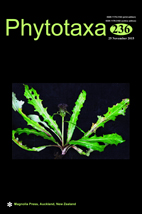Abstract
Platichthys, a new genus of canal raphe bearing diatoms, is formally described following analysis of the frustule morphology using LM and EM examination. The genus type originates from a thermal spring in the temperate climate zone of Chile, and an example of the second member of this new genus is observed from a coastal lagoon on the Galápagos Islands (Isabela Island). Taken together, the morphological features of these two newly described taxa demonstrate a unique set of characteristics observed within Thalassiophysaceae, Bacillariaceae and Entomoneidaceae. Platichthys gen. nov. contains both a canal raphe and fibulae, and the compressed valve face, absence of distinct valve mantle and numerous open porous copulae found in Platichthys gen. nov. are typical of Entomoneidaceae. However, unlike species belonging to Entomoneis, the valves of the new genus do not show frustule twisting and the striae are composed of single simple areolae instead of double rows. The most characteristic feature of the new genus is raphe positioned on an elevated keel, robust tubular fibulae, the strongly developed, steep valve face and an indistinct valve mantle in a form of a narrow structureless strip. The relationships of Platichthys gen. nov. to Nitzschia subgenus Nitzschia and to other sections of Nitzschia sensu lato, Entomoneis and to Hamatusia are discussed.

